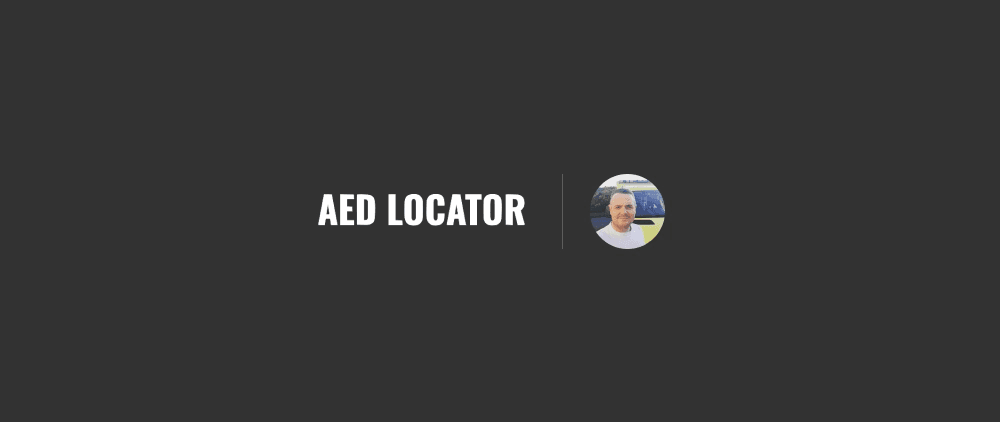Sudden cardiac arrest means your heart suddenly and unexpectedly stops pumping blood. It can happen to anyone, at any time.
There are medical devices called automated external defibrillators (AEDs) that deliver electric shocks to help restore your heart’s rhythm, but time is of the essence—the faster the response, the higher your probability of survival.
William Fahy is a full-time paramedic based in Ireland. After helping on countless cardiac arrest responses, he noticed a pattern: most people don't know where to find nearby AEDs.
When every second counts, informing the community about where to find publicly accessible AEDs could help save countless lives. But up to that point, there was no list or database of nearby AEDs William could share with his community. So he decided to build his own.
In this story, we’ll take a look at how William built an AED Locator app using Google Sheets and Retool, and how he manages a database of thousands of life-saving AEDs all over Ireland as a one-person team.
William needed a fast, and free, way to map out local AEDs in his area, so he got started with Google Sheets as his data backend. He used this single spreadsheet to collect all of the AED information he could find, including:
- Address and Eircode
- Latitude and longitude (for even more accuracy)
- Location category and type (AEDs are commonly found in sports arenas, hospitals, schools, and even private residences)
- Description/instructions (you often have to enter a building to locate the AED; some AEDs are locked behind access codes)
- Availability (Is the AED available 24/7? Hours of operation for the building it’s in?)
- Status (Is it active and functional? Has it been removed?)

With the help of different communities and groups on Facebook, he was able to get over 800 AEDs located and added to his database in less than a month from announcing the initiative.
But, even so, all of the data entry was manually collected, vetted, and added by William himself. He wanted to spend more time building an app to help people in Ireland find and source AEDs all over the country, but he was drowning in manual work. That’s when he started to look for a way to build a better frontend for his database.
Before becoming a paramedic, William had built a career in IT and software development. He adds, “my coding skills are mostly from the late 90s. I am familiar with basic HTML, JavaScript, and Access.”
He liked that Google Sheets offered enough database capabilities to get him started, but found that it was a “disaster” to customize into a simple user interface. The spreadsheet interface was not going to cut it for helping users quickly find nearby AEDs. It also wasn’t the optimal way for community members to add more AEDs. For both of these cases, he’d need to build a custom interface.
He decided to use Retool because it connected “seamlessly” with Google Sheets, and the app building experience felt natural for the former developer. Once he got his Google Sheet connected, he decided to build 4 different views into a Retool application:
- A search engine-inspired home page for anyone to locate nearby AEDs
- A spreadsheet view for people to explore more details about each AED
- A form for community members to submit new AEDs for review
- A stats page to help them prioritize expansion across Ireland
The search engine interface starts with a simple text input where users enter an address, zip code, or county name. A modal pops up with a map view that features all of the AEDs in the local radius and includes details about each one as the user clicks through the map.

The spreadsheet view gives users the ability to explore the database without requiring William to worry about any of the cells accidentally getting updated—it’s read-only for all users. At the same time, it’s side-by-side with a panel that offers a detailed view, including a map view for each AED.

He also built a form for users to quickly add new AEDs to his review queue—William still validates all entries via additional testing to ensure that the database remains as accurate and helpful as possible.
William also figured that community members might not know how to get latitude or longitude for a given address. Using the Google Maps API, he built the form so users can input an address or eircode and have everything else filled out automatically.

Finally, he built a statistics page into the app to give the community a broader idea about the AEDs by region, by location type, and more.
Knowing how many AEDs have been logged in hospitals or counties is not only interesting—it helps know where they need to double down to find the next gap in coverage.

While volunteering as an off-duty paramedic a few miles from his home, William responded to an emergency call about a cardiac arrest. When he arrived at the scene, two young boys were arriving at the same time with an AED in hand.
It turns out, those two boys were classmates with William’s daughter who had shared a bit about AED Locator with the class. The two boys had used the app to learn where nearby AEDs were located and—when an emergency struck—they were able to use that knowledge to help save a life. It was a major validation for William, and inspired him to keep growing the project.
As luck would have it, growth came from all kinds of places. After watching a Euro cup soccer game—where the lack of a nearby AED had created quite the news cycle—William’s wife posted about the importance of AED tracking on Facebook.
Within 24 hours, the community had added 370 more AEDs to the database. Within a week, they had hit 54K visits to their Facebook page and were featured on the local news.

Today, AED Locator has over 3,000 AEDs in a database that span almost all of Ireland. And William believes there are thousands left to find and share.
William has a lot of exciting directions where he aims to take AED Locator next. He’s received interest from national charity groups to help formalize and create a collaborative Irish AED inventory database, as well as partner closer on more initiatives.
At the same time, he wants to continue to expand the products he builds for his community and community-first responders.
I would love to continue to develop apps for rescue services, front-line staff, and volunteers. I like that challenge. These groups are not looked after enough. If I can provide services that help them and help my community, I want to do it.
Reader



